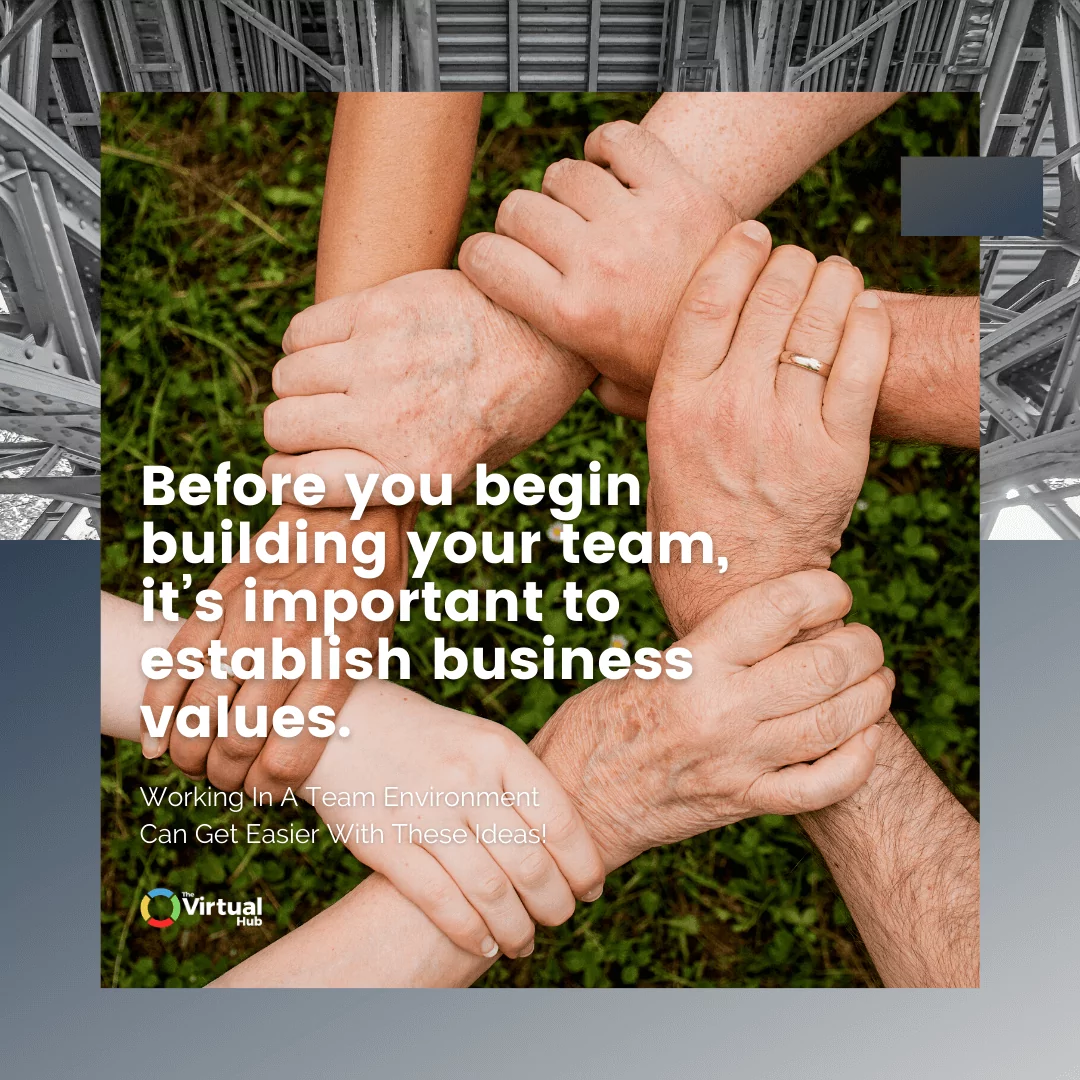Developing and maintaining a strong team environment will not only help improve employee motivation and satisfaction, but can also boost performance, innovation, and productivity.
However, creating the right team environment for your company doesn’t happen overnight. It takes time and extra effort, but it’s definitely worth it!

Here are a few ways you can help strengthen the teams in your workplace.
RELATED: Managing Virtual Teams By Setting Expectations Right
9 Strategies for Improving Teamwork Environment in Your Workplace
You can click on these links below to jump to a specific topic:
- What Is a Team Environment?
- What Are the Benefits to Working in a Team Environment?
- What Are the Challenges of Working in a Team Environment?
- How Do You Strengthen Your Teams?
1. Establish Your Company's Values
2. Participate in the Hiring Process
3. Get To Know Your Team
4. Define Roles Clearly
5. Set Realistic Group Goals
6. Model and Encourage Effective Communication
7. Upskill Your Team
8. Don’t Rely on Team Building Activities
9. Maximize Technology
What Is a Team Environment?
A team environment is a collaborative workplace where employees work together to meet common goals. In a team environment, each member has a role and responsibility, and they're held accountable for their performance.
However, it's important to remember that a team is only as strong as its weakest member. Therefore, it's essential to make sure that everyone on the team has a positive contribution. If someone is not pulling their weight, it can drag the whole team down.
To be successful, team members must be able to work effectively. Team environments can promote creativity and innovation, as well as provide support and motivation. When employees feel invested in the success of the group, they're more likely to perform at their best.
Ultimately, a team environment can be a great way to get unlimited access to the resources and expertise you need for your business to succeed.
What Are the Benefits to Working in a Team Environment?
Working in a team can be a great way to get things done. Here are the many benefits to working in a team environment:
It Can Help to Improve Communication
When you work on a team, you quickly learn the importance of open communication.
In order to complete joint projects successfully, everyone needs to be on the same page. This can be challenging when everyone has different ideas, but it's also an opportunity to improve your communication skills.
Working in a team environment forces you to listen to others and express your own ideas clearly. It's also a great way to practice compromise and conflict resolution.
It Can Help to Build Trust
In order to improve team effectiveness, employees need to be able to rely on their colleagues. This sense of trust can be built through shared knowledge and experiences, such as working towards a common purpose or overcoming a difficult challenge.
As team members learn to trust each other, they're more likely to feel comfortable sharing their ideas and collaborating. This trust can also lead to greater innovation, as team members feel confident that their ideas will be heard and valued.
It Can Help to Improve Problem-Solving and Critical Thinking Skills
When it comes to problem-solving, there is strength in numbers. Working as part of a team can help to improve critical thinking skills by providing a diversity of perspectives.
Brainstorming sessions can generate more and better ideas than working alone, and team members can challenge each other to think outside the box.
What Are the Challenges of Working in a Team Environment?
Working in a team can be both rewarding and challenging. On the one hand, you have the opportunity to collaborate with others and pool your collective talents. On the other hand, you also have to learn to compromise, communicate effectively, and manage conflict.
Here are some challenges you may face when working in a team environment:
Getting everyone on the same page: This can be difficult when you have other team members with different communication styles, work habits, and goals.
Managing conflict: When you have multiple people working towards a common goal, there will inevitably be disagreements along the way.
Coming to a group consensus: This can be time-consuming, since all members of the team need to discuss and debate the options before coming to a decision.
Being flexible and adaptable: It's important to remember that teams are not static; they're constantly changing and evolving. As new members join and old employees leave, it's important to be flexible and adaptable. The successful team is one that's always learning and growing along with its members.
How Do You Strengthen Your Teams?
As any leader knows, a strong team is essential to achieving success. But what are the best ways to strengthen your team? Here are a number of ways:
1. Establish Your Company's Values

Before you begin building your team, it’s important to establish business values.
What are your company/business values? These refer to a set of principles or philosophy that your company or business stands for.
Business values can include:
- Personal principles (ex: respect, integrity, or passion)
- Workplace beliefs or attitudes (ex: adaptability, commitment, or collaboration)
- Behavior standards (ex: excellence, dependability, or professionalism)
Your core business values will help direct business and management choices. They can also help guide your employees' interaction with customers and their colleagues.
Pro Tip: If you’re still working on your company's core values, why not try involving key members of the team? If you allow for a sense of ownership in the process, they’re more likely to embrace and embody those values.

2. Participate in the Hiring Process
When you’re looking for new team members, try to involve yourself in the hiring process.
Many companies outsource hiring tasks to their human resource offices, but they probably won’t know the ins and outs of your team as well as you do.

A human resource officer may have the ability to screen prospective employees in terms of their skill set and previous job experience, but they may miss out on more subtle personality traits that could make or break your team environment.
If you participate in the hiring process, you can watch out for this and ask more relevant interview questions.
For instance, if flexibility is important in your team environment, then this is something you can look into during interviews. One-on-one interaction with prospective employees can help you gauge their willingness to be a part of the team.
Pro Tip: If you’re unable to involve yourself in the hiring process, consider involving another team leader instead. Your team leader should be able to tell you if the new hire is a good fit.
RELATED: 4 Ways To Build A Positive Work Culture With Your Virtual Team
3. Get To Know Your Team

You need to know your group members’ strengths and weaknesses to build an effective team. Each team offers a unique combination of personalities and skill sets, so there’s no single path to team success.
The insight you gain from getting to know your team members is invaluable. It’ll allow you to maximize their potential, motivate them meaningfully, and offer opportunities for growth.
On top of that, it can also help develop trust and rapport between you and the individual members of your team. So take the time to really get to know the group of people you’re working with.
Pro Tip: Try to maintain a manageable team size. It may be harder to get to know your team if you’re working with a large group.

4. Define Roles Clearly
Everyone on your team should know their role or position. Each role should have an official job description.
What is a job description? It's a formal document that describes the tasks and duties of a particular role. Ideally, this should be made clear to the employee from the get-go.

Think about it: you’re more likely to get things done if you know what you need to do. It also helps prevent conflict and redundancies in the team.
All of this paves the way for better teamwork. Each team member needs to understand how they’re contributing to the common goal.
Pro Tip: Having clearly defined roles can help you avoid micromanaging your team. Studies show that micromanaging can have a negative impact on your team’s morale and productivity.
"An organization needs to set long-term goals so that employees know where the company is heading."
5. Set Realistic Group Goals

An organization needs to set long-term goals so that employees know where the company is heading. It may take a company five years or more to achieve a long-term goal.
The road to achieving long-term goals is paved with the fulfillment of many short-term goals. So it’s equally important to set short-term goals for your team.
It’s easier to track your team’s progress when the goals are clear and measurable. For larger organizations with multiple teams, leaders may set different team goals.
Pro Tip: It helps to have regular check-in meetings to make sure all your team members meet deadlines and targets.

6. Model and Encourage Effective Communication
Good communication is essential in any work environment. Organizationally, it’s helpful when the company provides communication guidelines that establish the flow of internal and external communications. A clear communications policy can save a lot of time because employees will know how to escalate their concerns.

As a leader, it’s vital to be an effective communicator. You need to make sure that the right information is reaching the right people in a timely manner.
It’s also easier to be a team player when the team environment promotes two-way communication between the leaders and their employees.
Here are a few ways you can demonstrate good communication skills:
- Actively listen to your team members when they’re speaking.
- Avoid interrupting others when they’re speaking.
- Give everyone a chance to speak in meetings.
- Create multiple channels for feedback.
- Follow-up verbal agreements with proper documentation.
- Update your team regularly.
- Recognize and reward good work.
- Provide timely and specific feedback and suggestions.
- Adjust your communication style to your audience.

Conflict and disagreement are inevitable in any environment, but good communication skills can help you navigate your way towards a resolution.
Pro Tip: If you have one member who is too shy to talk during meetings, try scheduling a one-on-one meeting with them.
"Providing employees the opportunity to advance their skill is a great way to enhance the team environment."
7. Upskill Your Team
Providing employees the opportunity to advance their skill is a great way to enhance the team environment. Employees feel more valued when leaders invest in their professional development.
Here are some common ways companies upskill their employees:

- Informal coaching
- Mentorship programs
- Seminars
- Conferences
- Short courses
Remember, skilled teamwork is only possible if you have skilled teammates. There’s always room for growth and improvement.
8. Don’t Rely on Team Building Activities

Developing rapport and trust among teammates helps promote a collaborative team environment. Team building activities may help facilitate this to some extent, but it takes time to develop these positive working relationships.
More often than not, employees dread team building activities. So if you can’t do away with them completely, try to balance them out with something more organic.
For example, why not try hosting a low-key social gathering instead? It’ll allow your team an opportunity to unwind and get to know one another a little better.
Hopefully, these informal social gatherings will help foster a closeness that translates into the workplace.
Pro Tip: If you can’t do away with HR-mandated team building sessions, try to plan it with them. That way, you can customize the activities. Remember, no one knows your team as well as you do!

9. Maximize Technology
There are a variety of tools you can use to help promote a collaborative environment.
For instance, instant messaging apps are great communication tools. Most instant messaging apps allow for both private messaging and group chats. Group chats are an easy way to make announcements or send reminders.

On top of that, there are also a variety of project management tools that can help you keep track of everyone’s progress. Popular project management tools include Zoho Projects, Trello, and Asana. With these tools, team leaders can check on the status of deliverables, while teammates can easily collaborate on a single project.

When face-to-face meetings are inconvenient, video conferencing is a great alternative. So it’s definitely possible to foster a positive team environment even if other members of your team are working remotely.
In fact, with these technological advancements, members of your team don’t even have to live in the same country to work together! Many successful businesses hire virtual assistants from across the ocean to support their daily operations.
Pro Tip: If you’re looking for some extra help, consider outsourcing tasks to a virtual assistant.
Final Thoughts
Successful businesses are run by great teams. You can’t force your team to work together, but a positive work culture can help facilitate it. It may take some time and effort to create a collaborative working environment, but it’s worth it. And by following these tips, you’ll be on your way to turning your dream team into a reality!
